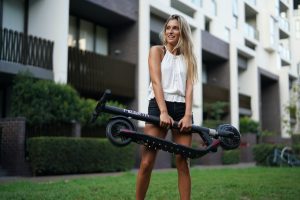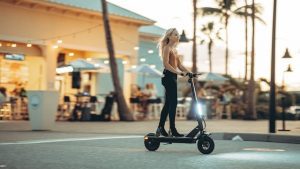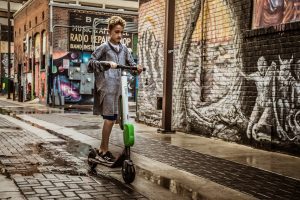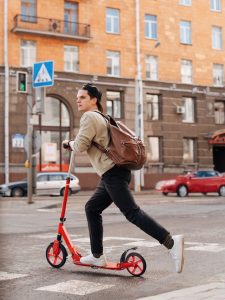Scooting can be a fun and eco-friendly mode of transport, but when raindrops start falling, it can also become a challenge. We understand the importance of having a scooter that can withstand wet weather to ensure a smooth ride and keep you safe.
Wet surfaces increase the risk of slipping and slow braking response, so choosing a scooter designed for these conditions is crucial. Everything matters, from the material and build quality to tire selection, brake system, and waterproof storage options.

At FamilyHype, we can provide guidance on choosing the best scooter for rainy days and tips for riding in wet weather. We want your rainy scooting experience to be enjoyable, safe, and comfortable, so you can make the most out of your journey.
Don’t forget to share your feedback with us – we would love to hear your thoughts and experiences! Our goal is to help you select the perfect scooter, whether it’s a gas, electric, or foldable scooter, so that you can have a safe and enjoyable ride come rain or shine.
Key Takeaways
- Choosing a scooter designed for wet conditions is crucial for safety and a smooth ride.
- Good front and rear lights and bright colors or reflective surfaces enhance visibility in rainy conditions.
- The right tread pattern and softer tire compounds increase traction and control on wet surfaces.
- Rainproof accessories like waterproof seat covers and slip-resistant handlebar grips provide stability and safety in wet conditions.
Understanding The Risks Of Wet Weather Scooting
It’s crucial for you to comprehend the perils associated with scooting in wet weather, as it can significantly impact your overall safety and enjoyment. Wet surfaces inherently risk slipping or losing control, especially when rain visibility is reduced. In addition, scooter lighting often isn’t designed for optimal visibility during wet weather, making it more difficult for other road users to see you. One of the best ways to address these challenges is by ensuring your scooter is equipped with a new and long-lasting battery that remains protected against moisture.
We understand your passion for scooting, yet we also want to ensure you remain safe while serving others. These risks don’t mean you should avoid wet weather completely, but rather that you should prepare adequately for it. The key lies in choosing a scooter designed to handle these conditions, which we will delve into next.
Importance Of Design For Wet Conditions
Don’t underestimate your two-wheeler’s design role when zipping through water-soaked streets! Rainy visibility is a crucial aspect you should consider. A design that incorporates bright colors or reflective surfaces can significantly enhance your visibility to other road users, reducing the risks of accidents.
Moreover, scooter lights are indispensable for wet weather rides. Good front and rear lights illuminate your path and make you noticeable in the downpour. We recommend scooters with durable, waterproof lights for a safe and fun rainy ride.

We’re not just concerned about your safety but also your comfort and the longevity of your scooter. So, let’s dive into the importance of the scooter’s material and build quality for enduring the relentless showers.
Material And Build Quality
Your electric scooter’s material and build quality are crucial for endurance during those relentless showers. You should choose a robust build made from materials that resist corrosion and are water resistant.
This will make your vehicle last longer and keep you safe when riding in the rain. Remember, rust prevention is key here. A vehicle that rusts easily can become dangerous, as parts may weaken or break off. So, when you decide to ride an electric scooter, especially during heavy rain, ensure you choose one made from rust-proof materials or those with rust-resistant coatings.
But don’t forget; that while your vehicle’s material and build quality are important, it’s equally essential to pick the right tires for wet weather. We’ll talk more about this next.
Tire Selection For Wet Weather
As we dive deeper into choosing the right scooter for showery day rides, let’s shift our focus onto an element that’s often overlooked but of utmost importance: the tires.

The tread pattern and the tire material greatly affect how well it handles wet surfaces. It’s crucial to choose wisely here, folks because the right tires can significantly enhance your safety and riding experience, while the wrong ones can easily make a wet ride risky and uncomfortable.
Tread Pattern
Choosing a scooter with the right tread pattern isn’t just about aesthetics; it’s crucial for maintaining grip and control during wet weather conditions. It’s about safety and serving ourselves and our community by reducing the risk of accidents.
- Deep grooves: These channel water away from the contact patch, increasing traction.
- Sipes: Tiny slits in the rubber surface that provide additional grip, acting like suction cups on wet surfaces.
- Blocky patterns create sharp edges that can dig into the road surface, providing extra control.
Rainproof accessories like a good set of scooter lights can also heighten visibility, but they can’t compensate for a bad tread pattern.
Let’s shift gears and focus on tire material and its importance for wet weather performance.
Tire Material
We’re not just talking aesthetics here; tire material matters greatly, especially when maintaining grip and control on slippery surfaces. For a safe ride during wet weather, we recommend using tires made from softer compounds. They have better traction in wet conditions, reducing the risk of skidding.
In addition to the right tires, consider investing in rainproof clothing. It doesn’t just keep you dry but also helps you maintain focus on the road. Furthermore, scooter lighting is crucial for visibility during these rides. A well-lit scooter increases your visibility to other road users, enhancing your safety.
So, while riding in the rain can be fun, it’s important to prioritize safety.
Brake System Considerations
Let’s dive into brakes, an often overlooked but crucial safety aspect, especially when riding your scooter in the rain.
We’ll compare disc and drum brakes, highlighting their unique strengths and potential drawbacks when handling wet roads. If you own a waterproof electric scooter, you might feel more confident about its ability to tackle wet conditions, but for those with water resistant electric scooters, it’s even more vital to understand the nuances of braking.
Moreover, we’ll delve into essential brake maintenance and safety tips that can help ensure a safe and smooth ride, even when the skies open up. It’s also worth noting that understanding your scooter’s top speed can help in adjusting your riding style during wet conditions.
Disc Brakes Vs. Drum Brakes
When riding in wet weather, you’ll want to understand the difference between disc and drum brakes on your scooter.
D-disc brakes are typically more durable and provide better stopping power in wet conditions than drum brakes. Disc brakes are usually exposed to the elements, which can lead to quicker wear but also means they’re less likely to be affected by water. Hence, their brake durability is higher.
On the other hand, drum brakes are enclosed, protecting them from debris but also means they may struggle in wet weather.

The brake installation process for disc brakes can be more complex, requiring regular maintenance.
Understanding these contrasts will help ensure a safe ride, regardless of the weather.
Next, we’ll delve into the crucial area of brake maintenance for rainy conditions.
Brake Maintenance During Wet Conditions
After deliberating over disc and drum brakes, we’ve honed in on the importance of brake maintenance, especially in wet weather. Our brakes need extra care in rainy conditions to function optimally and keep us safe.
As a community dedicated to serving others, we strongly advise using waterproof lubricants. They’re designed to repel water, keeping our brake system in top shape no matter how wet it gets.
More so, consider brake shielding. It’s an added layer of protection that prevents water from directly hitting your brakes, ensuring they perform consistently even when wet. This way, we’re ensuring a fun ride and a safe one.
Scooter Stability
Maintaining stability on your scooter during downpours is crucial, as it directly impacts your safety and overall riding experience. We understand the challenge of wet conditions, making it vital to take certain precautions.
Investing in waterproof accessories can offer a protective layer against the elements and provide much-needed stability. These can range from waterproof seat covers to slip-resistant handlebar grips, ensuring you remain firmly in control.
Moreover, visibility enhancements such as reflective tape or LED lights can make a difference, helping you see and be seen in poor weather conditions.
Remember, being safe isn’t just about protecting yourself; it’s about creating a safer environment for everyone on the road.
Waterproof Storage Options
Imagine cruising along the city streets, only for a sudden downpour to drench all your belongings stashed in your scooter’s storage compartment – not the best scenario, right? We feel your pain. Fortunately, there are ways to safeguard your belongings from such unfortunate incidents.
One effective solution is to use waterproof covers. These covers shield your scooter’s storage compartment from the rain, keeping your belongings dry. Additionally, investing in waterproof accessories, such as bags and pouches, can provide an extra layer of protection. These accessories are typically made of materials that repel water, ensuring your items remain safe and dry.
Remember, a soggy ride isn’t just uncomfortable; it can also cause damage to your scooter and your belongings.
Next, let’s look at how to keep your scooter in top shape for wet weather rides.
Maintenance For Wet Weather
As we all know, wet weather can be tough on our scooters. Conducting regular checks and thorough post-rain cleanups is critical to ensure our rides stay in shape.
Let’s remember a little caution and proactive care can go a long way in extending the lifespan of our scooters and keeping our rides smooth and safe, even in the wettest weather conditions.
Regular Checks
Don’t overlook the importance of routine inspections for your ride-on, especially when planning to ride in the rain. Like us, they need a bit of extra care in damp weather. Regular checks can help identify potential issues early and ensure safety.
Waterproof accessories, such as covers and handlebar grips, can provide an extra layer of protection. We recommend looking for products specifically designed for wet weather. Visibility enhancements are crucial too. Reflective decals or lights can make you more visible to other road users in wet weather conditions.
Remember, we’re keeping them in tip-top shape and serving others by making the roads safer.
Post-Rain Cleanup
Once the downpour has ceased, you must properly clean up your two-wheeler. This is to maintain its aesthetics, prevent mold, and ensure a safer ride next time.
We recommend three main steps:
- Drying it off: Use a soft, absorbent towel to dry off your scooter. This helps to prevent rusting and other water damage.
- Checking for mold: Pay special attention to areas where water might have accumulated, as these spots are breeding grounds for mold.
- Lubricating: Apply lubricant to the moving parts of your scooter. This keeps them running smoothly and prevents rust.
These drying methods and regular maintenance will keep your scooter in top shape.
Safety Gear For Wet Weather Scooting
You’ll feel secure knowing you’ve equipped yourself with the right safety gear for hurrying in the rain. We understand the passion for scooting doesn’t wane with a downpour. We encourage you to invest in waterproof clothing, a key component of your wet weather gear. It keeps you dry and prevents you from catching a cold.
Visibility aids are another essential you shouldn’t overlook. In the rain, visibility can drastically reduce, making it harder for you and others to see you. Consider reflective jackets and helmets or attaching lights to your scooter. Remember, safety can’t be compromised.
Now that you’re geared up let’s delve into the art of navigating through puddles and slippery roads in the rain.
Tips For Riding A Scooter In The Rain
As we venture out in unpredictable weather, there are several precautions we can’t afford to overlook. We’ve got to be extra mindful of observing speed limits, as wet roads can significantly alter our scooter’s grip and braking capacity.
Avoiding puddles is another key measure, as they can hide dangerous potholes, and let’s not forget to allow for safe stopping distances to prevent any unwelcome surprises.
Observing Speed Limits
Navigating through slick streets, keeping a tight rein on your scooter’s speed is crucial to prevent hydroplaning or losing control. We understand how tempting it can be to speed up, especially when you’re all decked out in waterproof clothing. However, remember that wet weather brings with it visibility issues.

We’d hate for you to miss a hazard or underestimate a turn because you were going too fast. By observing speed limits and going even slower if necessary, we’re looking out for our safety and the safety of pedestrians and other road users. It’s a simple act of kindness that can prevent accidents and keep everyone safe.
Avoiding Puddles
Dodging those sneaky puddles that appear out of nowhere can be a real game-changer in your journey. It’s not merely about keeping yourself dry; puddle splashbacks can create safety hazards too. When the wheels of your vehicle hit a deep puddle, water can splatter onto your gear and reduce your visibility. This is particularly dangerous when it affects your helmet visor or glasses.
We don’t want anyone to face such risks while being out there, serving their community, or just going about their day. So, always stay vigilant for puddles and learn to swerve safely. Remember, it’s not just about avoiding a wet ride; it’s about ensuring your safety and the safety of others.
Let’s focus on understanding and maintaining safe stopping distances in wet conditions.
Safe Stopping Distances
In your travels, it’s crucial to understand and maintain proper stopping distances, especially when conditions are less than ideal. Rain visibility can significantly affect your ability to gauge distances, potentially causing you to stop abruptly or not in time.
To ensure a safe and enjoyable ride, here are a few guidelines we recommend:
- Increase your following distance: Wet conditions require more time for your ride-on to stop. Allow extra space between you and the vehicle ahead.
- Use headlights: This increases your visibility to others and can help illuminate your path in heavy downpours.
- Reduce speed: Slower speeds allow for safer and more controlled stops.
Conclusion
We’ve walked you through choosing a scooter for rainy conditions with FamilyHype. The right design, materials, and tires can make all the difference. Don’t forget to check out the brake system, waterproof storage, and regular maintenance. And never forget your safety gear.
Riding during wet weather can be fun, but it’s not without risks. Stay safe, stay dry, and enjoy your ride.
Scooters come in various styles, shapes, and sizes, and choosing the right one for wet weather can be challenging. Some are designed for speed, while others are built for stability and safety. It’s also important to consider the type of terrain you’ll be riding on. If you plan to ride on slippery surfaces, ones with larger tires and a broader base will be better.
We hope this article has helped you make an informed decision about choosing a scooter for wet weather. Please let us know if you have any feedback or questions about your experience. We would love to hear from you!
Frequently Asked Questions
Which scooter is best in the rain?
When riding scooters in the rain, choosing one with good water resistance is important. Look for ones specifically designed for wet conditions or those with high water resistance ratings, such as IPX4 or higher.
Waterproof electric scooters are the way to go when riding in wet conditions. The best waterproof electric ones are designed with ingress protection and advanced water resistance features, making them ideal for tackling wet conditions.
They have sealed components and specialized designs that prevent water from entering sensitive areas. With the growing demand for electric scooters, manufacturers increasingly focus on creating water-resistant models. Most electric ones on the market now come with varying degrees of water resistance.
Whether commuting or enjoying a leisurely ride, having a waterproof electric scooter ensures you can confidently navigate through light showers or encounter water splashes without worrying about damaging the electrical system.
Can I ride a scooter in the rain?
You can ride a scooter in the rain, but taking the necessary precautions is important. Ensure your scooter has adequate water resistance to withstand light showers and splashes. Riding in heavy downpours or during storms is not recommended.
What electric scooter is safe in the rain?
Electric scooters with high water resistance ratings, such as IPX4 or higher, are considered safe for riding in light rain. They are designed to withstand water splashes and light precipitation, but they may not be suitable for heavy downpours or submerging in water.
One of the key features to look for when searching for an electric scooter suitable for riding in the rain is its water resistance. Electric waterproof or water-resistant ones offer high protection against moisture and foreign bodies. While it’s rare to find a completely waterproof electric one, many models today are designed to withstand light showers and water splashes.
They are equipped with water-resistant components and have undergone rigorous testing to ensure their reliability in wet conditions. Some even come with higher ingress protection ratings, like IPX4 or higher, which means they can handle light showers, water splashes, and high-pressure water sprays.
Additionally, certain models feature regenerative braking systems (regen brakes) that provide better control and traction when riding fast on wet pavement. Choosing a water-resistant electric scooter with advanced features allows you to enjoy a safe and smooth ride, even in light showers or wet environments.
Are electric scooters waterproof?
While some electric scooters are advertised as waterproof, it’s important to note that no scooter is completely waterproof. However, certain scooters have higher water resistance levels and can handle light rain and water splashes without significant damage.
Can you ride a Vespa in the rain?
When riding a Vespa in the rain, taking certain precautions is advisable. Firstly, ensure that your Vespa is equipped with proper rain protection features, such as fenders and splash guards, which help minimize water splashes and protect critical components. Additionally, consider wearing appropriate rain gear, such as a waterproof jacket and pants, to keep yourself dry and maintain visibility.
Maintaining good visibility is essential when riding in wet conditions, so ensure your Vespa’s lights and indicators function correctly. Consider using a waterproof cover for your vehicle when parked to provide extra protection from the elements.
Can electric bikes get wet in the rain?
Electric bikes, like electric scooters, can handle light showers and water splashes. Most electric bikes are designed with water-resistant components, such as sealed batteries and protected electrical connections. However, avoiding riding in heavy downpours or submerging the bike in water is advisable.
Can rain damage electric bikes?
Rain alone is unlikely to damage electric bikes, especially if they have appropriate water resistance measures. However, prolonged exposure to heavy downpours or submersion in water can potentially cause damage to the electrical components. It’s best to protect electric bikes from excessive water exposure whenever possible.
Can rain damage an e-bike?
Rain can damage an e-bike if exposed to heavy downpours or submerged in water for an extended period. The electrical components of the bike can be vulnerable to water ingress, leading to malfunctions or damage. Protecting e-bikes from excessive water exposure and ensuring proper water resistance is essential.
Are electric motorcycles safe in the rain?
Electric motorcycles, similar to electric scooters, can be safe to ride in light showers or drizzle, provided they have adequate water resistance. However, it’s crucial to exercise caution and avoid riding at high speeds or through heavy downpours, as this can impact the bike’s traction and safety.
What happens if you leave an electric scooter in the rain?
Leaving an electric scooter in the rain can potentially cause damage to its electrical components and accelerate wear and tear. Prolonged exposure to water can lead to electrical malfunctions, corrosion, or rust. It’s advisable to store them in a dry place or use covers to protect them from rain when not in use.
Please note that while many electric scooters and bikes offer water resistance features, it’s always recommended to check the manufacturer’s guidelines and take necessary precautions to protect them from excessive water exposure.
DISCLAIMER (IMPORTANT): This information (including all text, images, audio, or other formats on FamilyHype.com) is not intended to be a substitute for informed professional advice, diagnosis, endorsement or treatment. You should not take any action or avoid taking action without consulting a qualified professional. Always seek the advice of your physician or other qualified health provider with any questions about medical conditions. Do not disregard professional medical advice or delay seeking advice or treatment because of something you have read here a FamilyHype.com.